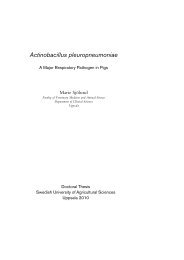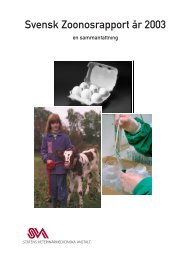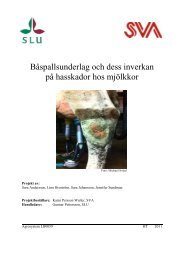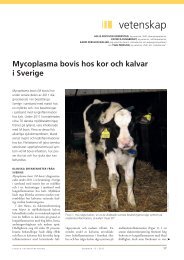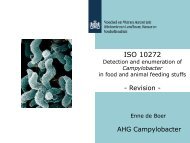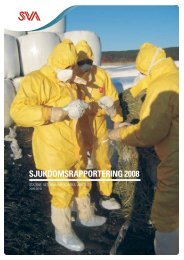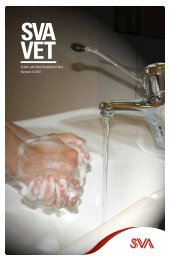(MRSP) hos svenska hundar - SVA
(MRSP) hos svenska hundar - SVA
(MRSP) hos svenska hundar - SVA
- No tags were found...
You also want an ePaper? Increase the reach of your titles
YUMPU automatically turns print PDFs into web optimized ePapers that Google loves.
Bacterial swabs where sampled from 23 Swedish dogs with known carriership of<strong>MRSP</strong>. Samples where collected on two occasions from four different locations:the nose, around anus, the pharynx and from any infected area on the dog. If thedog was asymptomatic, samples ere instead taken from lip commissures.Culturing and identificationing and antimicrobial susceptibility tests were carriedout in compliance with c<strong>hos</strong>en method. Oxacillin resistant colonies whereindirectly tested for the presence of the mecA gene with latexagglutination andthis is used to confirm it as a <strong>MRSP</strong>.Among the 23 dogs that where sampled, almost 86 % where still positive withinone to five months time. After six to thirteen months, almost 77 % of the dogswere sampled negative for <strong>MRSP</strong>. <strong>MRSP</strong> was isolated from one dog 12 monthsafter it was first diagnosed. All of the dogs had been treated with antimicrobialswithin three months prior to <strong>MRSP</strong> culture. Among the dogs that tested positivefor <strong>MRSP</strong> both dogs with and without clinical symptoms of infections wherefound. Above all, two diagnoses where prominent in the study; post operativewound infections and pyoderma. All of the dogs had been treated at veterinaryclinics and 16 of 23 dogs had been <strong>hos</strong>pitalised more than two nights.Rigourous hygiene routines are imperative in preventing spread of infection.Diminished use of antimicrobials and increased bacterial sampleing, includingresistance patterns, are further steps essential in reducing the selection for <strong>MRSP</strong>.INLEDNINGStaphylococcus pseudintermedius (tidigare Staphylococcus intermedius) är en avhundens vanligaste hudbakterier och har vid ett försök isolerats från huden <strong>hos</strong> enmajoritet (65 %) av friska <strong>hundar</strong> (Holm et al., 2002). Staphylococcuspseudintermedius är en opportunistisk patogen som kan orsaka pyodermi,endometrit, cystit, otitis externa och andra suppurativa tillstånd <strong>hos</strong> hund (P.J.Quinn, 2002). Spridning av bakterien kan ske via direktkontakt, aerosol, <strong>hos</strong>ta ochäven via saliv (Malik et al., 2005). En klon av Staphylococcus pseudintermediusmed en förvärvad resistens mot en majoritet av de antibiotika som används inomveterinärmedicinen idag, har de senaste åren spritt sig i Sverige (<strong>SVA</strong>RM, 2007).Bakterien benämns meticillinresistent Staphylococcus pseudintermedius (<strong>MRSP</strong>).<strong>MRSP</strong> påvisades för första gången 2006 <strong>hos</strong> en svensk hund (Zwenson, 2007) ochytterligare fall skulle isoleras från <strong>svenska</strong> <strong>hundar</strong> samma år. Totalt 13 isolatgjordes i Sverige år 2006, samtliga isolerades från postoperativa sår (<strong>SVA</strong>RM,2006). År 2007 var siffran uppe i 77 isolat (<strong>SVA</strong>RM, 2006) (se Figur 1).9


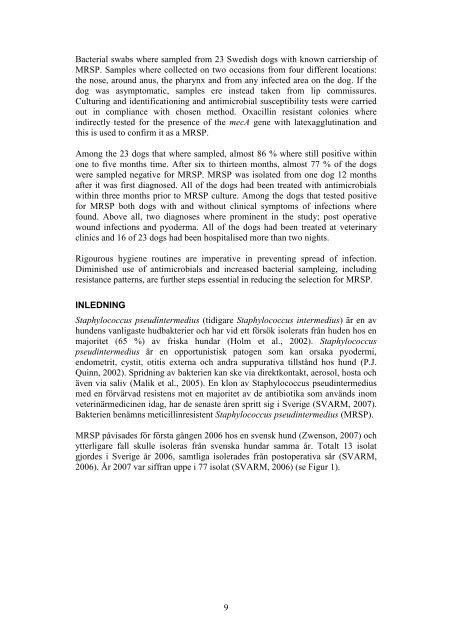
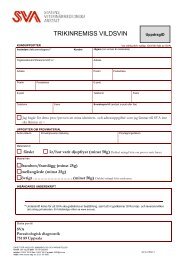
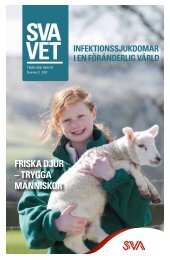
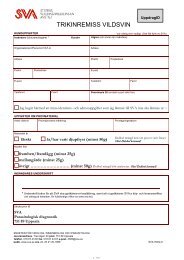
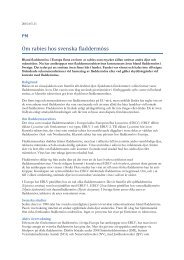
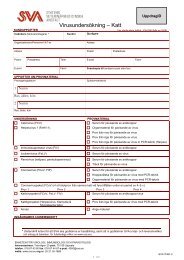
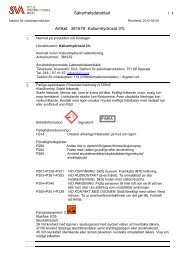
![Uppsala nfo z NRL pro kampylobaktery .ppt [režim kompatibility] - SVA](https://img.yumpu.com/48904877/1/190x135/uppsala-nfo-z-nrl-pro-kampylobaktery-ppt-rea-3-4-im-kompatibility-sva.jpg?quality=85)
